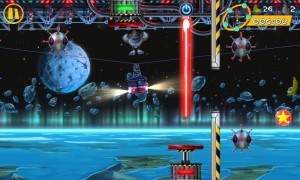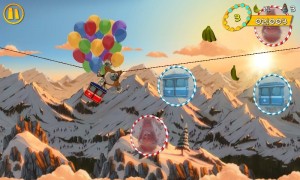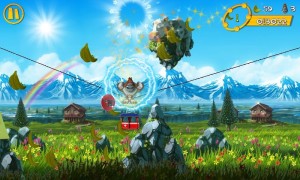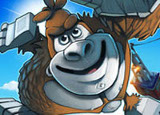 We’re aware that Gorilla Gondola features swipe, tap, and tilt controls, but what does each of these do in-game, exactly? Does the player use some input types to control the gorilla and other input types for the gondola, or is only one or the other under the player’s direct influence?
We’re aware that Gorilla Gondola features swipe, tap, and tilt controls, but what does each of these do in-game, exactly? Does the player use some input types to control the gorilla and other input types for the gondola, or is only one or the other under the player’s direct influence?
Dean: Gorilla Gondola is all about the safe progression of the gondola to the end of the level, but it’s up to Gorilla to get it there. As the gondola is a lifeless entity, the player has to control Gorilla, so for example, if he stomps down hard, the gondola will start swinging up and down. We decided to use the touch, swipe and tilt to (excuse the pun) tap into the widest spectrum of control inputs so we could keep the gameplay fresh, whilst remaining intuitive. So, swipe is used to make the gorilla jump and stomp down, and tilt is used to control the gondola leaning left and right, which also influences the scrolling speed a bit.
EU: What’s quite a neat touch (excuse the pun) is that we also kind of “break the fourth wall” by making the player touch specific items in the levels to activate them, which is essential to progress. You are Gorilla, but you are also an outside force that changes the game world. I’d like to think we get a lot out of essentially simple controls.
Dave: With our control system we’re trying to make the most of the current gaming devices and the tap, swipe and tilt controls work brilliantly. They’re very intuitive and after a very short time with the game, you find yourself bouncing round the place collecting bananas with ease. Later on in the game you’ll need to activate and deactivate objects by tapping on their respective switches, all of which add to the gaming experience.
 Would you describe Gorilla Gondola primarily as an action game, a puzzle game, or a mix of both? What are some of the power-ups the player can collect, and how do these help Gorilla reach his goal?
Would you describe Gorilla Gondola primarily as an action game, a puzzle game, or a mix of both? What are some of the power-ups the player can collect, and how do these help Gorilla reach his goal?
Dave: I see Gorilla Gondola as an action game. It’s easy to pick up but can take a while to master. You’ll find that you learn to time your jumps and stomps better through experience, which helps get Gorilla through the various levels smoothly and rack up a better score.
Dean: Yes, it’s definitely leaning more towards an action game. The screen is always moving, and there’s rarely time to catch your breath before the next thing hell bent on preventing you from getting Gorilla home comes along.
EU: Some rather quick thinking is often required to choose the best way through an obstacle sequence. There are basic patterns to this you’ll learn, so that subsequent playthroughs will really improve your score.
Without saying too much, power-ups include some staples of the videogame world, like invincibility, and a magnet that sucks in power-ups, but also some helium balloons that make you float high above the fray for a bit if you can collect them.
Dean: I’d probably describe Gorilla Gondola as a “bounce-em-up.” Maybe we’ve created a new genre here.
 Tell us a little about the game’s smart level generator, and how it keeps subsequent playthroughs fresh. Did this prove especially challenging to implement on a technical level, and what’s the key to maintaining a good difficulty balance when levels are generated in such a way?
Tell us a little about the game’s smart level generator, and how it keeps subsequent playthroughs fresh. Did this prove especially challenging to implement on a technical level, and what’s the key to maintaining a good difficulty balance when levels are generated in such a way?
EU: With the amount and nature of obstacles we have, going completely random was ruled out very early on. So the idea is that we have a pretty big database of small level chunks, several hundreds of them, that we’ve designed by hand.
Dave: Initially we were typing in item coordinates by hand in code! It was taking far too long and we couldn’t implement changes quickly enough. I had a chat with a good friend of mine who’s a Flash wizard and we came up with a graphical level editor within a very short time. This allowed us to re-iterate and fine tune our level chunks much more efficiently. It made a massive difference to our work flow and it’s something we certainly couldn’t do without.
EU: Yes, the editor has been a lifesaver. So for each of these chunks we assign a difficulty, and at runtime, the game is told to generate a level of a certain difficulty rating and containing a number of specific obstacle types. There’s also a bit of extra stuff going on so it avoids repeating itself. So a level will always have a different composition on each play through, but you will occasionally encounter familiar elements.


